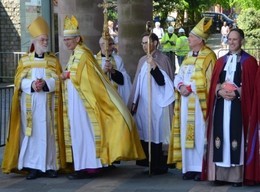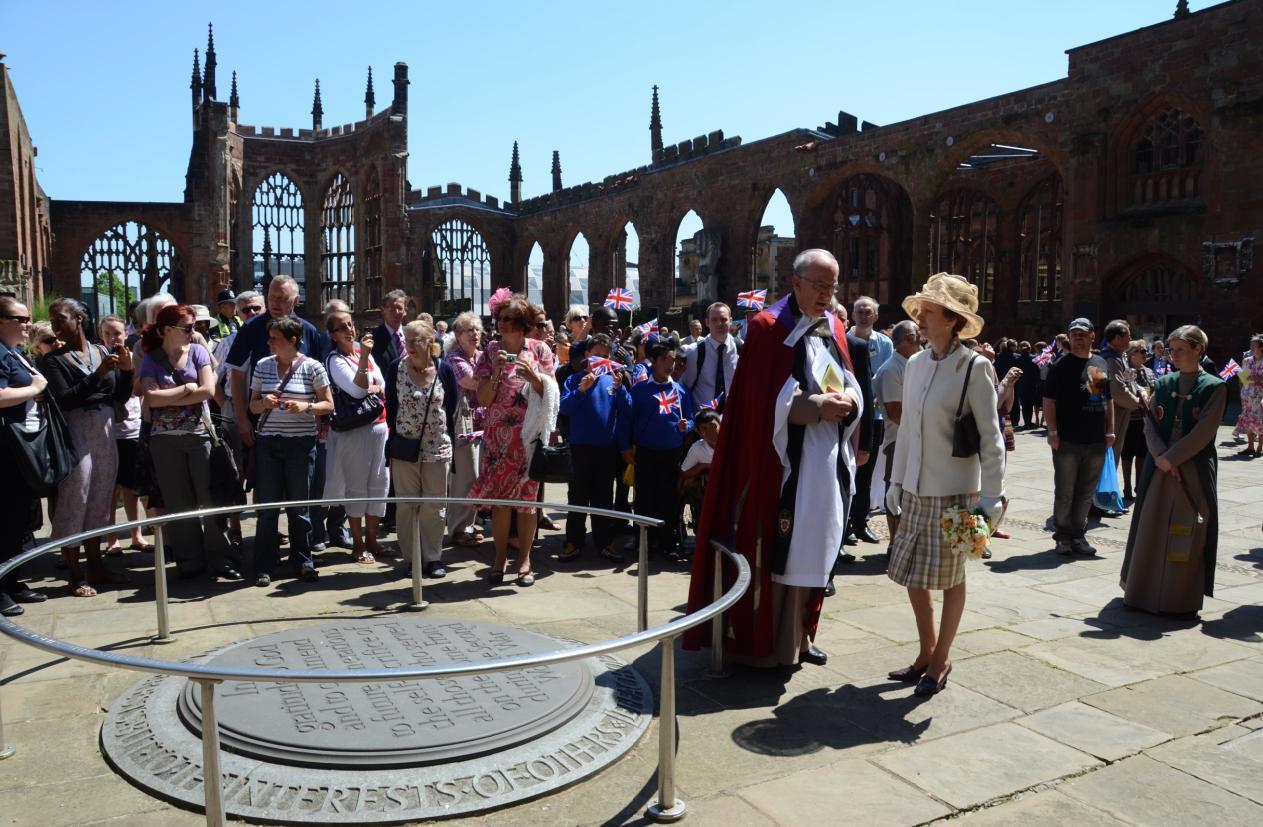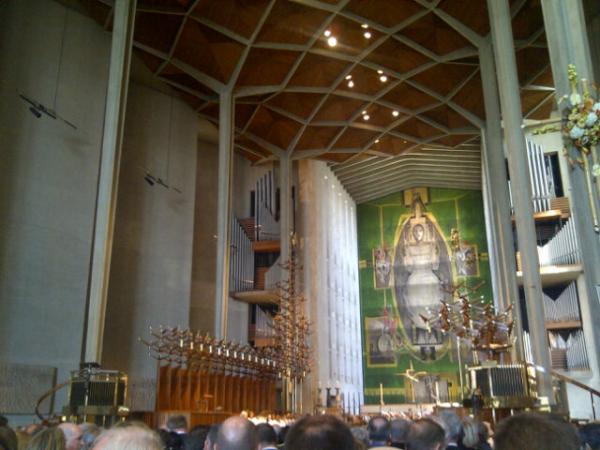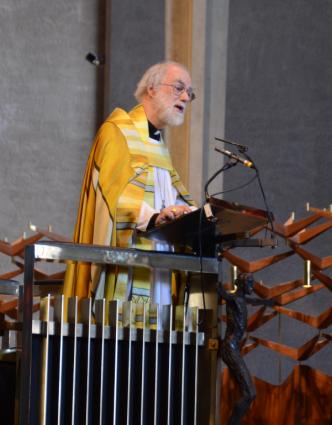Archbishop - Coventry Cathedral gives us the gift of vision
 Archbishop Rowan with the Bishop of Coventry, the Rt Revd Dr Christopher Cocksworth. Photo: Diocese of Coventry
Archbishop Rowan with the Bishop of Coventry, the Rt Revd Dr Christopher Cocksworth. Photo: Diocese of CoventryFriday 25th May 2012
Archbishop Rowan Williams preached at Coventry Cathedral in a service to celebrate the Cathedral's Golden Jubilee. The guest of honour was HRH Princess Anne, and the celebration was attended by around 1800 people and also aired live on the city centre big screen in Millennium Place.The service took place exactly 50 years - to the day - after HM the Queen and Princess Margaret attended the consecration of the new cathedral in 1962. The previous St Michael's Cathedral was bombed during the Coventry Blitz on 14 November 1940. The new Coventry Cathedral was designed by Sir Basil Spence and stands alongside the ruins of the old cathedral as a symbol of peace and reconciliation.
During his sermon, the Archbishop noted that "reconciliation does not happen unless we learn to see differently" and that "the cathedral teaches us to see the world anew".
Speaking on the lines "Enable with perpetual light / the dullness of our blinded sight" from the hymn Come, Holy Ghost, Our Souls Inspire, he said:
"A sacred building ought to be one in which we are learning to see, a building that teaches us not only by the words spoken, the written Word of God, the preaching of that Word, the teaching that goes on. It should be a building that helps us to see afresh."
Listen to the Archbishop's sermon here, or read the transcript below.
The ceremony included a procession from the city’s old and new cathedrals, and prayers were said in the ruins of the old cathedral. The national anthem was played and a posy of newly-cultivated Coventry Cathedral roses was presented to the Princess Royal during the proceedings.
The entire service can be heard at BBC Cov & Warks.

Princess Anne with the Dean of Coventry in the cathedral ruins
Sermon by Archbishop Rowan Williams
Coventry Cathedral Golden Jubilee Service
25 May 2012
Readings: 2 Chronicles 6.40-7.4; Revelation 1.12-18
"Enable with perpetual light
the dullness of our blinded sight."
So we sing when we pray for the gift of the Holy Spirit at Pentecost; at confirmations; at ordination services. We need to learn how to see, and we pray that the Holy Spirit will open our eyes.
Reconciliation does not happen unless we learn to see differently. We all know how pain, injury and humiliation affect our seeing – as if we were locked in darkness; as if we could only see ourselves and our past and our experiences in our own terms, in our own light, as we sometimes say. To be reconciled is to be able to see the other freshly and clearly - to see the person we thought a stranger or an enemy, and to see ourselves afresh. To see the past differently, and to see that there is a future. “Enable with perpetual light, the dullness of our blinded sight.” Teach us to see freshly; teach us to see the world anew – and then we shall be drawn into the ministry of reconciliation.
A sacred building ought to be one in which we are learning to see, a building that teaches us not only by the words spoken, the written Word of God, the preaching of that Word, the teaching that goes on. It should be a building that helps us see afresh. And I want to reflect for a moment on what, quite literally, we see in this particular cathedral. What is it that we are being taught to see? How are our eyes opened in this place?

We enter from that unforgettable West End. And at first, as always when we come into a building of this size, it feels – it seems – dark. And our eyes are led by a series of uncompromising grey slabs up towards the east, and the dimly perceived image that hangs behind the high altar. We walk towards it, our eyes on that image, watching its contours take shape before us.
“I saw one like the son of man, clothed with a long robe, with a golden sash across his chest.” The first thing this building teaches us is to see Jesus. Walking towards Him, gradually allowing our vision to be clarified as we look at that great image; one of the iconic images of the late twentieth century, surely. Our eyes on Him - but surely also our eyes on that elusive, mysterious figure that we finally see, between the feet of the throned Christ, that simple, naked, vulnerable human figure, clamped firmly between the feet of the Lord.
And perhaps, as we walk towards this image of Christ, we see there also the human being held in Jesus Christ, looking out with Him. Perhaps, as we walk towards the east, we begin to ask ourselves, what does that human figure see? What does a man or woman see, whose humanity is held like that, clamped between the feet of the glorified Lord?
We walk towards it, and inevitably, at some point, we turn around. And we see what that naked, vulnerable human figure sees. We see that those uncompromising grey slabs have been transformed into the light of the windows that lead us inexorably towards the light of Christ. We look back, and through the screen we see those ruins which speak so powerfully, so compellingly, of human evil and human destruction.
We look back, and we see the greyness of the walls transformed to light. And we see the memory of evil and destruction through that screen on which are the servants of God; the saints and the angels. The devastation, the slaughter, the humiliation and injury that those ruins speak of, we see now not as unreal, not as any less horrific than we ever thought, but in and through the presence of those who have loved and served their maker and redeemer. We see that the story of the past is never simply a story of horror and violence. God has not left Himself without witnesses – and there they are, etched in the glass, around the memory of human evil; the memory of those who have served love; who have lived and died for reconciliation.
That’s what the eyes of Christ see. That’s what the eyes of that human being between his feet see. We walk here; we turn; we see the past transformed. We see the future laid open. We see from the place where Christ sees.
What an extraordinary claim to make. What an ambitious thing for a cathedral to try and tell us. But no more ambitious than St Paul, when he says “we have the mind of Christ”. (1 Corinthians 2:16) If we have the mind of Christ, we begin to see what Christ sees. That is where we stand, clamped between His feet, looking in the direction He is looking. Looking at the history of a world that has been scarred and wrecked by all manner of greed; all manner of evil and atrocity. Looking with His witnesses and His servants. Looking in His own light at the past of humanity, and drawing it together in a new light; in a new creation.
Give me a place to stand, said the ancient mathematician [Archimedes], and I will move the globe. Well, we have been given a place to stand. A place from which, in the power of the Spirit and the risen Lord, we can move the globe. And there is that place: between the feet of the glorified Christ, looking out at a world not instantly or magically healed, but held. Held; worked with in love and hope. That is what we are being taught in this building – and the ‘dullness of our blinded sight’ is being opened up in that gift of vision.
 That is when reconciliation begins. Seeing the past of violence and conflict; surrounded by the presence of those who have still tried to serve the Lord, seeing the uncompromising grey of struggle and effort turned into light, into transparency, seeing the wreckage of the image of the cross held up before us on that table of the Lord; twisted, distorted, and still itself. All of that caught up, of course, in that image so central to the life of this place: the cross of nails. The cross which you see around the necks of all those who are part of this family. The cross which was given to all those ships of Her Majesty’s navy, carrying the name of Coventry. The cross recovered from the wreckage of HMS Coventry, and now in HMS Diamond; a tradition continuing, a presence still alive. The past brought alive: held, worked with, moved inch by inch and day by day towards reconciliation.
That is when reconciliation begins. Seeing the past of violence and conflict; surrounded by the presence of those who have still tried to serve the Lord, seeing the uncompromising grey of struggle and effort turned into light, into transparency, seeing the wreckage of the image of the cross held up before us on that table of the Lord; twisted, distorted, and still itself. All of that caught up, of course, in that image so central to the life of this place: the cross of nails. The cross which you see around the necks of all those who are part of this family. The cross which was given to all those ships of Her Majesty’s navy, carrying the name of Coventry. The cross recovered from the wreckage of HMS Coventry, and now in HMS Diamond; a tradition continuing, a presence still alive. The past brought alive: held, worked with, moved inch by inch and day by day towards reconciliation.
That is what this building teaches. And what this building asks of us, and challenges us about, is where we want to stand. Do we want to stand only among the ruins? Do we want to stand in a place where we cannot see anything except the memory of horror and offence?
Or do we want to walk? Do we want to begin the journey down this nave; to stand where Christ stands? To let ourselves be clamped between the great grey walls of this cathedral as if clamped between the feet of Jesus Christ, and to look, as if for the first time, at our world; at our past; at our own injuries and the injuries of others – and to know that it is held and transfigured in His presence, His love and His power. “Whose head and hair were white as wool; white as snow, His eyes like a flame of fire. Who was dead and is alive. Who has the keys of death and Hades.” Who makes us see. Who unlocks our prison. Who makes us live.
© Rowan Williams 2012
